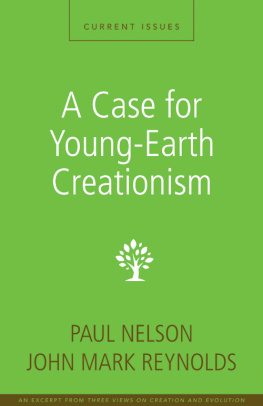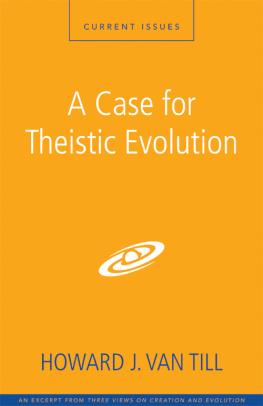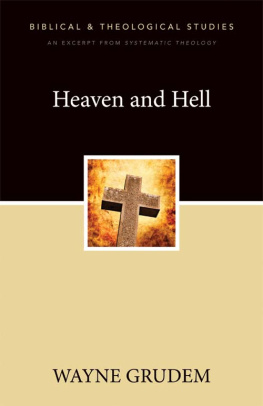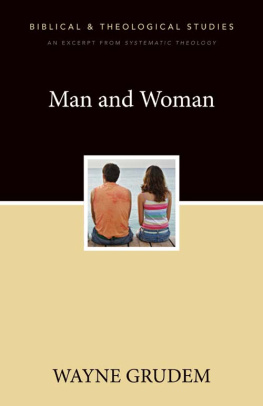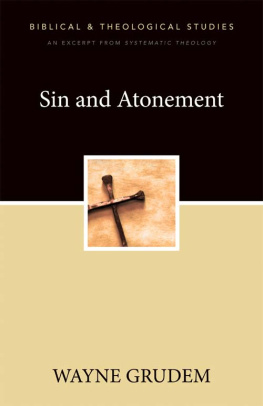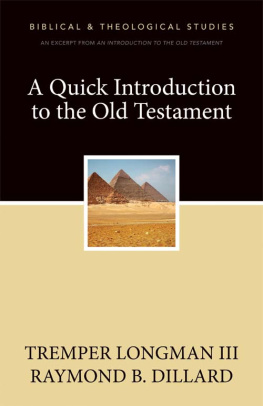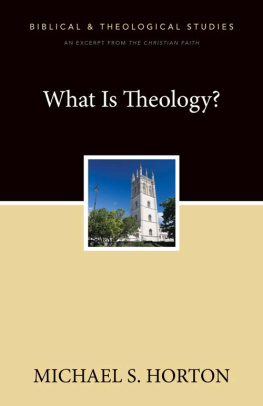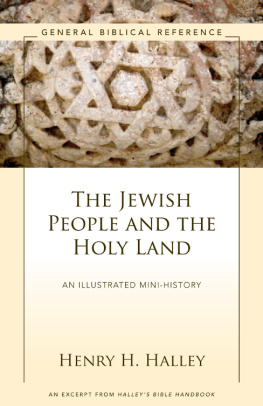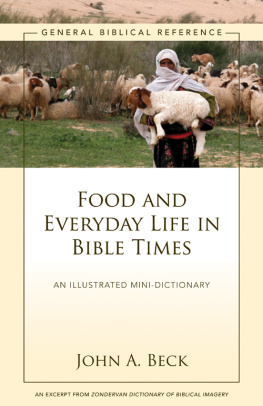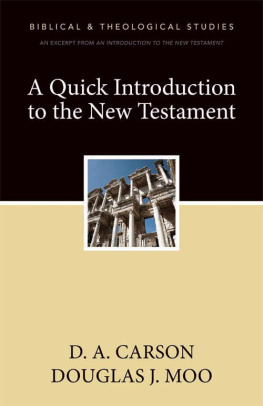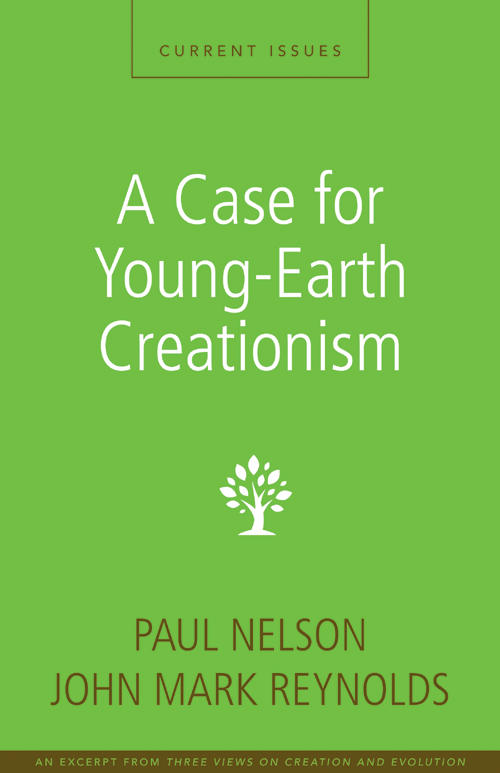Zondervan
A Case for Young-Earth Creationism
Previously published in Three Views on Creation and Evolution
Copyright 1999 by J. P. Moreland and John Mark Reynolds
All rights reserved under International and Pan-American Copyright Conventions. By payment of the required fees, you have been granted the non-exclusive, non-transferable right to access and read the text of this e-book on-screen. No part of this text may be reproduced, transmitted, downloaded, decompiled, reverse engineered, or stored in or introduced into any information storage and retrieval system, in any form or by any means, whether electronic or mechanical, now known or hereinafter invented, without the express written permission of Zondervan.
EPub Edition JANUARY 2012 ISBN: 978-0-310-49644-1
Requests for information should be addressed to:
Zondervan, Grand Rapids, Michigan 49530
The Library of Congress has cataloged the original edition as follows:
Three views on creation and evolution / J. P. Moreland and John Mark
Reynolds, general editors; contributors, Paul Nelson[et al.]; respondents,
John Jefferson Davis[et al.]., First.
p. cm.(Counterpoints)
Includes bibliographical references and index.
ISBN 0-310-22017-3
1. Creationism. 2. EvolutionReligious aspectsChristianity. I. Moreland, James Porter, 1948-. II. Reynolds, John Mark, 1963-. III. Nelson, Paul. IV. Davis, John Jefferson. V. Series: Counterpoints (Grand Rapids, Mich.)
BS651. T485 1999
231.7652dc21
98-33239
All Scripture quotations, unless otherwise indicated, are taken from the Holy Bible: New International Version. NIV. Copyright 1973, 1978, 1984 by International Bible Society. Used by permission of Zondervan. All rights reserved.
Any Internet addresses (websites, blogs, etc.) and telephone numbers in this book are offered as a resource. They are not intended in any way to be or imply an endorsement by Zondervan, nor does Zondervan vouch for the content of these sites and numbers for the life of this book.
All rights reserved. No part of this publication may be reproduced, stored in a retrieval system, or transmitted in any form or by any meanselectronic, mechanical, photocopy, recording, or any otherexcept for brief quotations in printed reviews, without the prior permission of the publisher.
Cover design: Ron Huizinga
Paul Nelson and John Mark Reynolds
Paul Nelson and John Mark Reynolds
1. OVERALL POSITION
We hold the view of recent or so-called young earth creation. Unfortunately, neither young earth nor recent is satisfactory as a descriptive adjective. If you are asked to give your age on a legal form, you do not write old, young, recent, or any other relative term; rather, you give an exact number. The world is precisely as old or as young as it actually is. Young earth creation is thus a confusing misnomer, seeming to imply that the earth or universe are young relative to some unspecified (old) temporal reference point. (The virtuosi of the early scientific revolution thought that God had created the world within the biblical time span, but they would not therefore have described their cosmology as young or recent. They would have asked, Young or recent in reference to what?) This caveat should always be kept in mind when using terms like young earth or recent, which actually describe, and then imperfectly, differences between various theories about the timing of creation.
The young earth creationism position is that most often identified as creationism by the majority of scientists, educators, and the press, largely because (at least until recently) those persons most likely to come to public attention in the creation-evolution controversy as wanting changes in science education, urging legislation, or debating the issue on university and college campuses, were also most likely to hold young earth views. While neither recent or young earth is entirely satisfactory as a descriptive adjective, both terms can reasonably be applied to the general position we shall now describe.
The main distinguishing features of the recent creation position are:
- An open philosophy of science. (We define open in detail under 3. Philosophy of Science below.)
- All basic types of organisms were directly created by God during the creation week of Genesis 1-2.
- The curse of Genesis 3:14-19 profoundly affected every aspect of the natural economy.
- The flood of Noah was a historical event, global in extent and effect.
We amplify each of these points at the end of this section. Other distinctive aspects of the recent creation position (e.g., a historical Adam and Eve, directly created by God as the original parents of humankind) follow from these cardinal claims.
The largest organizations advocating recent creation include:
The Creation Research Society (CRS), established in 1963, with the geneticist Walter E. Lammerts as its first president. A scholarly society chartered solely for research and publication, the CRS includes six hundred voting members (defined as such by holding graduate degrees in science) and eleven hundred nonvoting members and publishes the Creation Research Society Quarterly, a technical research journal now in its thirty-fourth volume.
The Geoscience Research Institute (GRI), affiliated with Loma Linda University in Loma Linda, California, and Andrews University in Berrien Springs, Michigan. Established in 1958, the GRI, staffed by scientists from the Seventh-day Adventist church, publishes the biannual scholarly journal Origins, now in its twenty-fourth volume.
The Institute for Creation Research (ICR), Santee, California, established in 1972 by Henry Morris as an offshoot of Christian Heritage College in San Diego, California. ICR publishes books, technical monographs, and the monthly magazine Acts and Facts, and broadcasts an international radio program. Most of the best-known proponents of the young earth position (e.g., Henry Morris, Duane Gish, Ken Ham) are, or were, associated with the ICR.
Organizations and societies advocating recent creationism exist in other countries as well (e.g., Canada, Australia, Germany, England, and Korea), and dozens of local groups operate at the state and regional level, such as the Creation Science Fellowship in Pittsburgh, who sponsor the quadrennial International Conference on Creationism (ICC). Scientists currently working within the recent creation perspective include paleontologist Kurt Wise of Bryan College, geophysicist John Baumgardner of Los Alamos National Laboratory, physicist Russell Humphreys of Sandia National Laboratory, biologist Wayne Frair of the CRS, microbiologist Siegfried Scherer of the Technical University of Munich, and paleoanthropologist Sigrid Hartwig-Scherer of the University of Munich.
Let us now return briefly to the key features of the recent creation position. It may be helpful to consider each in a comparative table:
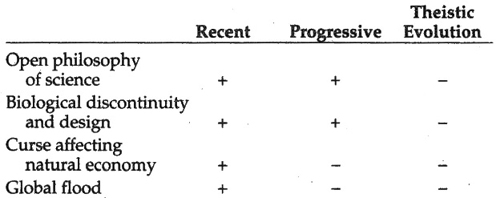
It will be generally true that recent and progressive creationists agree that one may infer God has acted directly from patterns of physical evidence (i.e., both schools of thought hold what we call an open philosophy of science). And, indeed, both recent and progressive creationists see the evidence as pointing to the direct action of God as a primary cause in the history of life. God created the major divisions of animals and plants directly. Furthermore, both positions hold the living state, life itself, to be a phenomenon that cannot be reduced to or derived from lower-level physical and chemical entities or causes. Organisms were directly designed by God as systems that, while they certainly rely on physical and chemical laws, would never come into being via those laws alone.

